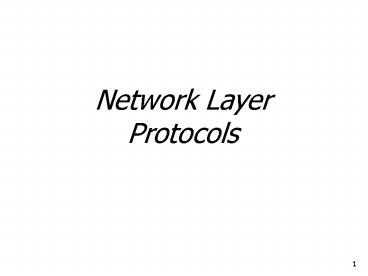Network Layer Protocols - PowerPoint PPT Presentation
1 / 51
Title:
Network Layer Protocols
Description:
The total length field defines the total length of the datagram ... (Airport, hotels) Ad hoc (Personal Area Networks) voice. data. Mobile Telephony Operators ... – PowerPoint PPT presentation
Number of Views:49
Avg rating:3.0/5.0
Title: Network Layer Protocols
1
Network LayerProtocols
2
Figure 20.1 Protocols at network layer
3
Figure 20.2 ARP operation
4
Note
An ARP request is broadcast an ARP reply is
unicast.
5
Figure 20.7 IP datagram
6
Note
The total length field defines the total length
of the datagram including the header.
7
Figure 20.8 Multiplexing
8
Figure 20.10 MTU
9
Figure 20.12 ICMP encapsulation
10
Note
ICMP always reports error messages to the
original source.
11
Figure 20.13 Error-reporting messages
12
Note
There is no flow control or congestion control
mechanism in IP.
13
Unicast and Multicast Routing
14
Figure 21.1 Unicasting
15
Note
In unicast routing, the router forwards the
received packet through only one of its ports.
16
Some Popular Unicast routing protocols
17
Figure 21.3 Autonomous systems
18
Table 21.1 A distance vector routing table
19
Figure 21.7 Areas in an autonomous system
20
Figure 21.14 Types of LSAs
21
Figure 21.17 Summary link to network
22
Figure 21.18 Summary link to AS boundary router
23
Figure 21.19 External link
24
Note
In OSPF, all routers have the same link state
database.
25
Dijkstra Algorithm
1. Start with the local node (router) the root
of the tree. 2. Assign a cost of 0 to this node
and make it the first permanent node. 3. Examine
each neighbor node of the node that was the last
permanent node. 4. Assign a cumulative cost to
each node and make it tentative. 5. Among the
list of tentative nodes 1. Find the node with
the smallest cumulative cost and make it
permanent. 2. If a node can be reached from
more than one direction 1. Select the
direction with the shortest cumulative cost.6.
Repeat steps 3 to 5 until every node becomes
permanent.
26
Table 21.2 Link state routing table for router A
27
Figure 21.23 Multicasting
28
Note
In multicast routing, the router may forward the
received packet through several of its ports.
29
Note
IGMP is a group management protocol. It helps a
multicast router create and update a list of
loyal members related to each router interface.
30
Wireless Networks
31
Wireless networks in comparison to fixed
networksKey Characteristics
- Higher loss-rates due to interference
- emissions of, e.g., engines, lightning
- Restrictive regulations of frequencies
- frequencies have to be coordinated, useful
frequencies are almost all occupied - Low transmission rates
- local transmission in Mbps, regional currently,
e.g., 9.6kbit/s with GSM - Higher delays, higher jitter
- connection setup time with GSM in the second
range, several hundred milliseconds for other
wireless systems - Lower security, simpler active attacking
- radio interface accessible for everyone, base
station can be simulated, thus attracting calls
from mobile phones - Always shared medium
- secure access mechanisms important
32
Frequencies for communication
coax cable
twisted pair
optical transmission
1 Mm 300 Hz
10 km 30 kHz
100 m 3 MHz
1 m 300 MHz
10 mm 30 GHz
100 ?m 3 THz
1 ?m 300 THz
visible light
VLF
LF
MF
HF
VHF
UHF
SHF
EHF
infrared
UV
- VLF Very Low Frequency UHF Ultra
High Frequency - LF Low Frequency SHF Super High
Frequency - MF Medium Frequency EHF Extra High
Frequency - HF High Frequency UV Ultraviolet
Light - VHF Very High Frequency
- Frequency and wave length ? c/f
- wave length ?, speed of light c ? 3x108m/s,
frequency f
33
Electromagnetic spectrum for wireless
communication
34
Frequencies for mobile communication
- VHF-/UHF-ranges for mobile radio
- simple, small antenna for cars
- deterministic propagation characteristics,
reliable connections - SHF and higher for directed radio links,
satellite communication - small antenna, focusing
- large bandwidth available
- Wireless LANs use frequencies in UHF to SHF
spectrum - some systems planned up to EHF
- limitations due to absorption by water and oxygen
molecules (resonance frequencies) - weather dependent fading, signal loss caused by
heavy rainfall etc.
35
Note
Infrared signals can be used for short-range
communication in a closed area using
line-of-sight propagation.
36
The Wireless Space
37
Emerging Landscape
Who will be the winner ?
38
Two options 802.11 and Bluetooth
Bluetooth
802.11
Cordless headset
Access Point
Designed for wired Ethernet replacement
Designed for cable replacement
39
An Ad-Hoc Wireless Network (MANET)
40
Vision of the Future
41
WirelessLANs
42
802.11 Market Evolution
802.11
43
BSSs
44
ESS
45
Physical layer specifications
46
IEEE 802.11 current status
LLC
MAC Mgmt
WEP
MAC
MIB
PHY
FH
IR
DSSS
47
Piconet
48
Scatternet
49
Wireless Technology Current Landscape
72 Mbps
Turbo .11a
54 Mbps
802.11a,b
5-11 Mbps
.11 p-to-p link
802.11b
1-2 Mbps
802.11
Bluetooth
µwave p-to-p links
3G
384 Kbps
WCDMA, CDMA2000
2G
56 Kbps
IS-95, GSM, CDMA
Outdoor 50 200m
Mid range outdoor 200m 4Km
Long range outdoor 5Km 20Km
Long distance com. 20m 50Km
Indoor 10 30m
50
Research Program
72 Mbps
Turbo .11a
54 Mbps
802.11a,b
5-11 Mbps
802.11b
.11b p-to-p link
1-2 Mbps
802.11
µwave p-to-p links
384 Kbps
WCDMA, CDMA2000, HDR
56 Kbps
IS-95, GSM, CDMA
Outdoor 50 200m
Mid range outdoor 200m 4Km
Long range outdoor 5Km 20Km
Long distance com. 20m 50Km
Indoor 10 30m
51
Concluding Remarks
- IEEE 802.11
- Will continue to grow in
- Public spaces, home, industry vertical, and
enterprise market - 802.11 will provide a viable alternative to 3G in
public places - Offers a great promise for bringing low cost
networking services to the Asia/Pacific mass
market - Bluetooth will be complimentary to WLANs, it will
not be a competitor - Interoperability between WLANs, WPANs and 3G
networks will be critical !































